NEET Previous Year Questions (2014-2024): Aldehydes, Ketones & Carboxylic Acids | Chemistry Class 12 PDF Download
2024
Q1: Fehling's solution 'A' is(a) aqueous copper sulphate
(b) alkaline copper sulphate
(c) alkaline solution of sodium potassium tartrate (Rochelle's salt)
(d) aqueous sodium citrate (NEET 2024)
Ans: (a)
Fehling's solution is a chemical reagent used to differentiate between water-soluble carbohydrates and ketone-functional groups, and as a test for monosaccharides. It is used specially in the Fehling's test for reducing sugars. The test involves two solutions, generally known as Fehling's A and Fehling's B, which are mixed together and added to perform the test.
Fehling's solution 'A' is an aqueous solution of copper(II) sulfate. Thus, the correct option is:
Option A: aqueous copper sulphate
The function of Fehling's A is to provide copper(II) ions, Cu2+, which act as the oxidizing agent in the reaction with the reducing sugar. When Fehling's Solution A and B are mixed and heated with a reducing sugar, the copper(II) ions are reduced to copper(I) oxide, which precipitates as a red solid, indicating a positive result.
Fehling's Solution B, on the other hand, contains alkaline sodium potassium tartrate, which helps to maintain the solution in an alkaline condition and keeps the copper(II) ions in solution.
Thus, in summary, Fehling's A consists of aqueous copper sulfate, which directly matches with Option A.
Q2: Match List I with List II.
Choose the correct answer from the options given below:
(a) A-IV, B-I, C-III, D-II
(b) A-III, B-I, C-II, D-IV
(c) A-IV, B-I, C-II, D-III
(d) A-I, B-IV, C-II, D-III (NEET 2024)
Ans: (c)
Q3: For the given reaction:
'P' is
(a) 
(b) 
(c) 
(d)  (NEET 2024)
(NEET 2024)
Ans: (b)
2023
Q1: Complete the following reaction: (NEET 2023)
[C] is _______.
(a) 
(b) 
(c) 
(d) 
Ans: (c)

Q2: Identify the major product obtained in the following reaction: (NEET 2023)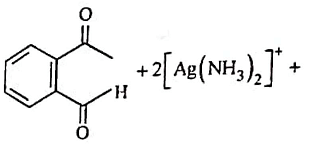 3 – OH
3 – OH  major product
major product
(a) 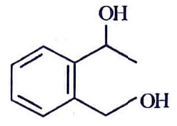
(b) 
(c) 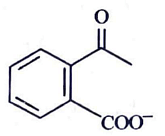
(d) 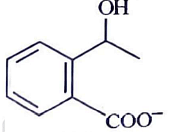
Ans: (c)
Ammoniacal silver nitrate solution is Tollens’ reagent. Tollens’ reagent can be used to distinguish aldehyde & ketone as aldehyde upon warming with Tollens’ reagent produces a silver mirror due to formation of silver metal in alkaline medium. Aldehyde is oxidised to corresponding carboxylate anion.
Q3: Identify the final product [D] obtained in the following sequence of reactions. (NEET 2023)

(a) 
(b) C3H10
(c) 
(d) 
Ans: (d)

2022
Q1: 
What is Y in the above reaction? (NEET 2022 Phase 1)
(a) RCOO-X+
(b) (RCOO)2Mg
(c) RCOO-Mg+X
(d) R3CO-Mg+X
Ans: (c)
Q2: Given below are two statements:
Statement I: The boiling points of aldehydes and ketones are higher than hydrocarbons of comparable molecular masses because of weak molecular association in aldehydes and ketones due to dipole-dipole interactions.
Statement II: The boiling points of aldehydes and ketones are lower than the alcohols of similar molecular masses due to the absence of H-bonding.
In the light of the above statements, choose the most appropriate answer from the options given below: (NEET 2022 Phase 1)
(a) Statement I is correct but Statement II is incorrect.
(b) Statement I is incorrect but Statement II is correct.
(c) Both Statement I and Statement II are correct.
(d) Both Statement I and Statement II are incorrect.
Ans: (c)
- The boiling points of aldehydes and ketones are higher than hydrocarbons of comparable molecular masses due to weak molecular association in aldehydes and ketones arising out of the dipole - dipole interaction.
- Acohols involved intermolecular hydrogen bonding, because of which the boiling point of aldehydes and ketones are lower than the alcohols of similar molecular masses.
Q3: Match List-I with List -II. 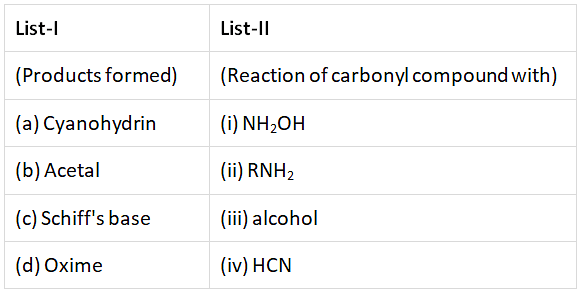 from the options given below correct answer Choose the (NEET 2022 Phase 1)
from the options given below correct answer Choose the (NEET 2022 Phase 1)
(a) (a) – (i), (b) – (iii), (c) – (ii), (d) – (iv)
(b) (a) – (iv), (b) – (iii), (c) – (ii), (d) – (i)
(c) (a) – (iii), (b) – (iv), (c) – (ii), (d) – (i)
(d) (a) – (ii), (b) – (iii), (c) – (iv), (d) – (i)
Ans: (b)
Cyanohydrin → HCN
Acetal → Alcohol
Schiff's base → R–NH2
Oxime → NH2–OH
Q4: Which one of the following is not formed when acetone reacts with 2-pentanone in the presence of dilute NaOH followed by heating? (NEET 2022 Phase 1)
(a) 
(b) 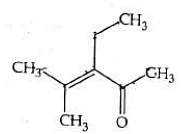
(c) 
(d) 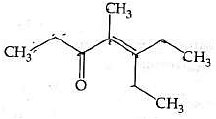
Ans: (d)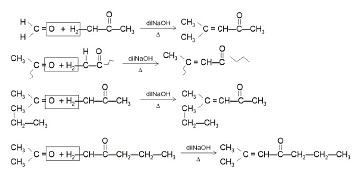
Q5: Compound X on reaction with O3 followed by Zn/H2O gives formaldehyde and 2-methyl propanal as products. The compound X is
(a) 3-Methylbut-1-ene
(b) 2-Methylbut-1-ene
(c) 2-Methylbut-2-ene
(d) Pent-2-ene (NEET 2022 Phase 1)
Ans: (a)
The given reaction is the reductive ozonolysis of an alkene. The alkene will be

Q6: The incorrect method to synthesize benzaldehyde is (NEET 2022 Phase 2)
(a) 
(b) 
(c) 
(d) 
Ans: (a)

Q7: Match List-I with List-II : (NEET 2022 Phase 2)

Choose the correct answer from the options given below :
(a) (a) - (iii), (b) - (iv), (c) - (ii), (d) - (i)
(b) (a) - (iii), (b) - (i), (c) - (ii), (d) - (iv)
(c) (a) - (ii), (b) - (iii), (c) - (i), (d) - (iv)
(d) (a) - (iv), (b) - (iii), (c) - (i), (d) - (ii)
Ans: (a)
- Gabriel phthalimide synthesis is used for preparation of aliphatic primary amines.
- Kolbe synthesis with phenol gives salicylic acid
- Williamson synthesis gives ether on reaction of alkyl halide and alcoxide
- Etard reaction gives benzaldehyde from benzene
Q8: The product formed from the following reaction sequence is (NEET 2022 Phase 2)

(a) 
(b) 
(c) 
(d) 
Ans: (c)

Q9: Which of the following reactions is not an example for nucleophilic addition-elimination reaction?
(a) CH3CHO + NH3
(b) 
(c) CH3CHO + NH2OH
(d) CH3CHO + C6H5NHNH2
Ans: (b)
It is an example of nucleophilic addition reaction

2021
Q1: 
Consider the above reaction and identify the missing reagent/chemical. (NEET 2021)
(a) CaO
(b) DIBAL-H
(c) B2H6
(d) Red Phosphorus
Ans: (a) Decarboxylation takes place by soda-lime (NaOH + CaO)
Decarboxylation takes place by soda-lime (NaOH + CaO)
Q2: Match List-I with List-II. (NEET 2021)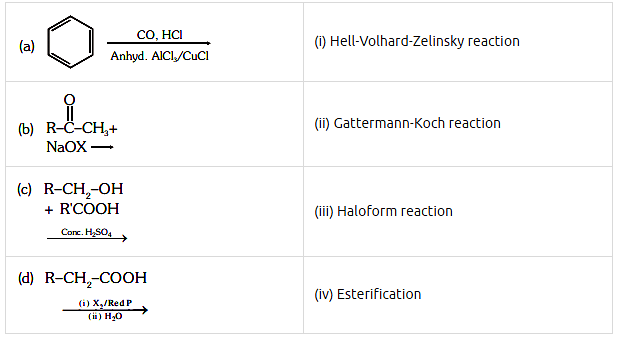 Choose the correct answer from the options given below.
Choose the correct answer from the options given below.
(a) (a)-(i), (b)-(iv), (c)-(iii), (d)-(ii)
(b) (a)-(ii), (b)-(iii), (c)-(iv), (d)-(i)
(c) (a)-(iv), (b)-(i), (c)-(ii), (d)-(iii)
(d) (a)-(iii), (b)-(ii), (c)-(i), (d)-(iv)
Ans: (b)
Q3: The product formed in the following chemical reaction is : (NEET 2021)
(a) 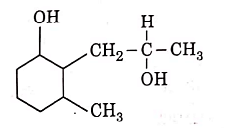
(b) 
(c) 
(d) 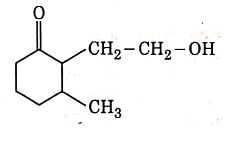
Ans: (b)
NaBH4 is a reducing agent. If reduces carbonyl group into alcohols but does not reduce esters.
Q4: The intermediate compound 'X' in the following chemical reaction is : (NEET 2021)
(a)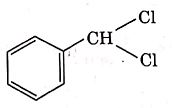
(b)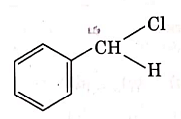
(c)
(d)
Ans: (c)
This is Etard reaction in which reaction of toluene with chromyl chloride in CCl4 followed by hydrolysis gives benzaldehyde. Toluene reacts with chromyl chloride to form a precipitate called the Etard complex.
Q5: What is the IUPAC name of the organic compound formed in the following chemical reaction?
 (a) 2-methylbutan-2-ol
(a) 2-methylbutan-2-ol
(b) 2-methylpropan-2-ol
(c) pentan-2-ol
(d) pentan-3-ol
Ans: (a)
IUPAC name of product is 2-methylbutan-2-ol.
2020
Q1: Identify compound X in the following sequences of reactions : (NEET 2020)
(a)
(b)
(c)
(d)
Ans: (a)
Q2: Reaction between benzaldehyde and acetophenone in presence of dilute NaOH is known as: (NEET 2020)
(a) Cross Cannizzaro’s reaction
(b) Cross Aldol condensation
(c) Aldol condensation
(d) Cannizzaro’s reaction
Ans: (b) In the presence of dil. OH- , benzaldehyde and acetophenone will react to undergo cross-aldol condensation.
In the presence of dil. OH- , benzaldehyde and acetophenone will react to undergo cross-aldol condensation.
Q3: Reaction between acetone and methylmagnesium chloride followed by hydrolysis will give :
(a) Sec. butyl alcohol
(b) Tert. butyl alcohol
(c) Isobutyl alcohol
(d) Isopropyl alcohol (NEET 2020)
Ans: (b)

2018
Q1: Carboxylic acid have higher boiling points than aldehydes, ketones and even alcohols of comparable molecular mass. It is due to their (NEET 2018)
(a) formation of intramolecular H-bonding
(b) formation of carboxylate ion
(c) more extensive association of carboxylic acid via vander Wall force of attraction
(d) formation of intermolecular H-bonding.
Ans: (d)
Due to the formation of intermolecular H-bonding, association occurs in carboxylic acids. So, they have higher boiling points than aldehydes, ketones and even alcohols of comparable molecular mass.

2017
Q1: Consider the reactions :- (NEET 2017)
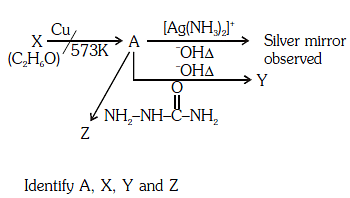
(a) A-Methoxymethane, X-Ethanol, Y-Ethanoic acid, Z-Semicarbazide.
(b) A-Ethanal, X-Ethanol, Y-But-2-enal , Z-Semicarbazone
(c) A-Ethanol, X-Acetaldehyde, Y-Butanone, Z-Hydrazone
(d) A-Methoxymethane, X-Ethanoic acid, Y-Acetate ion, Z-hydrazine
Ans: (b)
Since, A gives silver mirror test, it must be an aldehyde and aldehydes are formed by oxidation of 1o alcohols. Thus, ‘X’ is a 1o alcohol, i.e., CH3CH2OH. 
Q2: Of the following, which is the product formed when cyclohexanone undergoes aldol condensation followed by heating ?:- (NEET 2017)
(a)

(b)

(c)

(d)

Ans: (a)
 2016
2016
Q1: The correct order of strengths of the carboxylic acids (NEET 2016 Phase 2)

is
(a) I > II > III
(b) II > III > I
(c) III > II > I
(d) II > I > III
Ans: (b)
We know, Acidic strength ∝ – I effect
As oxygen is more electron withdrawing (II) and (III) show greater – I effect than (I). Thus, (I) is least acidic. Out of (II) and (III), (II) is more acidic than (III) as distance of O increases from —COOH group and acidic strength decreases.
Q2: Which of the following reagents would distinguish cis-cyclopenta-1,2- diol from the trans-isomer? (NEET 2016 Phase 1)
(a) Aluminium isopropoxide
(b) Acetone
(c) Ozone
(d) MnO2
Ans: (b)
Trans isomer does not react with acetone as removal of H2O molecule is difficult.
Q3: The correct statement regarding a carbonyl compound with a hydrogen atom on its alpha-carbon, is : (NEET 2016 Phase 1)
(a) a carbonyl compound with a hydrogen atom on its alpha-carbon rapidly equilibrates with its corresponding enol and this processes is known as keto-enol tautomerism .
(b) a carbonyl compound with a hydrogen atom on its alpha-carbon never equilibrates with its corresponding enol.
(c) a carbonyl compound with a hydrogen atom on its alpha-carbon rapidly equilibrates with its corresponding enol and this process is known as aldehyde-ketone equilibration.
(d) a carbonyl compound with a hydrogen atom on its alpha-carbon rapidly equilibrates with its corresponding enol and this process is known a carbonylation.
Ans: (a)
Keto-enol tautomerism is as follows :

2015
Q1: Treatment of cyclopentanone with methyl lithium gives which of the following species? (AIPMT 2015 Cancelled Paper)
with methyl lithium gives which of the following species? (AIPMT 2015 Cancelled Paper)
(a) Cyclopentanonyl biradical
(b) Cyclopentanonyl anion
(c) Cyclopentanonyl cation
(d) Cyclopentanonyl radical
Ans: (b)

Q2: An organic compound X having molecular formula C5H10O yields phenyl hydrazone and gives negative response to the iodoform test and tollen test. It produces n-pentane on reduction X could be
(a) n-amyl alcohol
(b) pentanal
(c) 2-pentanone
(d) 3-pentanone (AIPMT 2015 Cancelled Paper)
Ans: (d)
As the compound X yields phenyl hydrazone and gives negative response to the iodoform test and Tollen’s test so it must contain a C = O group but neither a methyl ketone nor in aldehyde. Thus, the structure of X will be

Q3:The oxidation of benzene by V2O5 in the presence of air produces (NEET / AIPMT 2015)
(a) maleic anhydride
(b) benzoic acid
(c) benzaldehyde
(d) benzoic anhydride.
Ans: (a)

2014
Q1: Which one is most reactive towards Nucleophilic addition reaction? (NEET / AIPMT 2014)
(a)

(b)

(c)

(d)

Ans: (b)
Electron withdrawing (–I, –M) groups are more reactive towards nucleophilic addition reactions. Thus, correct order is :

|
108 videos|286 docs|123 tests
|
FAQs on NEET Previous Year Questions (2014-2024): Aldehydes, Ketones & Carboxylic Acids - Chemistry Class 12
| 1. What are the common reactions of aldehydes and ketones? |  |
| 2. How can you distinguish between aldehydes and ketones? |  |
| 3. What are the properties of carboxylic acids? |  |
| 4. How do carboxylic acids react with bases? |  |
| 5. What is the importance of aldehydes, ketones, and carboxylic acids in organic chemistry? |  |

|
Explore Courses for NEET exam
|

|


















